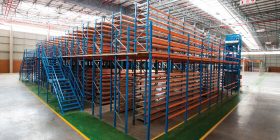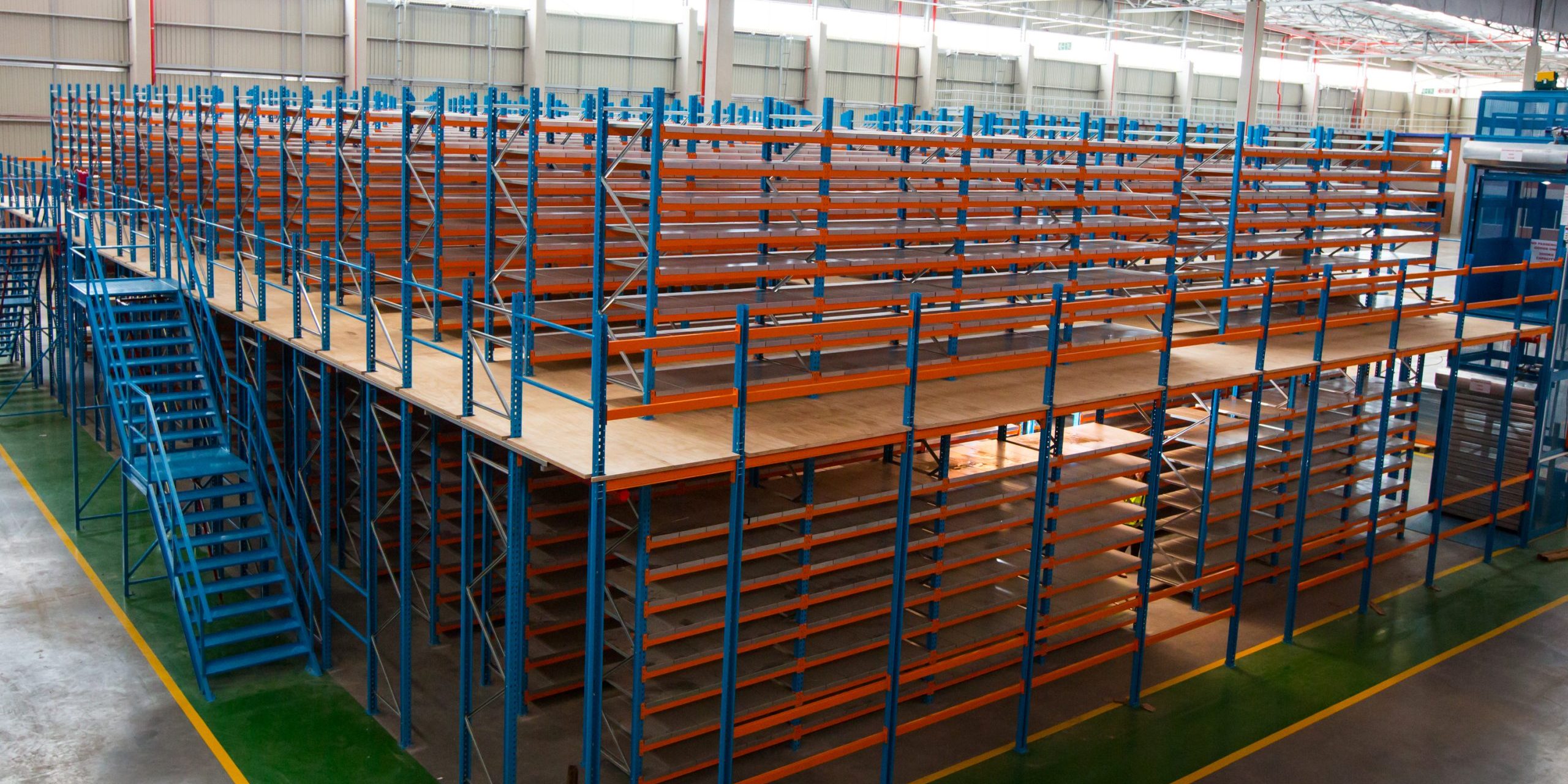When it comes to practical storage options, businesses often have to choose between Industrial rack-supported mezzanine floors vs. rivet shelving. Both systems provide distinct advantages, but they differ greatly in terms of installation and longevity. In this post, we’ll look at the differences between these two popular storage choices to help you decide which is best for your needs.
What is Rack-Supported Mezzanine Floors
Rack-supported mezzanine floors are built from pallet racking materials and can include shelving or racking with a lid on top, accessed by a staircase. The steel columns and racking or shelving can fully or partially support the floor above. This robust construction securely supports the upper floor and its contents, making it a reliable choice for expanding storage capacity.
One of the primary advantages of a rack-supported mezzanine floor is the ability to maximise vertical space. This makes it ideal for warehouses and storage facilities with high ceilings. With a rack-supported mezzanine floor, you can significantly increase your storage capacity without the need for extensive renovations or expansions. Additionally, the use of pallet racking materials ensures that these mezzanines are sturdy and capable of supporting heavy loads.
Advantages of Rack-Supported Mezzanine Floors
A rack-supported mezzanine floor offers maximised vertical space, utilising unused vertical areas to significantly increase storage capacity. These mezzanines are constructed from pallet racking materials, making them durable and capable of supporting heavy loads. They can be customised to fit the specific layout and storage needs of your facility, providing a permanent solution for growing businesses.
What is Rivet Shelving?
Rivet shelving, also known as rivet rack or boltless shelving, is an industrial shelving system that uses rivets to secure the shelves to the uprights. Unlike other shelving units, rivet shelving is assembled without bolts, nuts, or screws, making installation quick and straightforward. Adjusting the shelving heights is equally simple, requiring only a hammer or mallet.
Usually constructed from steel, rivet shelving is created for heavy-duty purposes. It is suitable for storing large and bulk items like boxes, tools, and equipment. The shelves are often made of particleboard or wire mesh, providing customisation options to fit specific storage needs.
One of the standout benefits of rivet shelving is its versatility. The design allows for easy addition or removal of shelves, adapting to changing storage requirements. This flexibility makes rivet shelving an ideal solution for warehouses, factories, and other industrial settings.
Benefits of Rivet Shelving
Rivet shelving provides several benefits. It is easy to assemble and does not require bolts, nuts, or screws, making installation quick and straightforward. Rivet shelving is versatile and can be easily adjusted to meet changing storage requirements. It is a cost-effective solution for heavy-duty storage needs. The shelves can be made from particleboard or wire mesh, allowing for customisation to suit different items.
Rack-Supported Mezzanine Floor Differences
The primary differences between a rack-supported mezzanine floor and rivet shelving lie in their structure and purpose. Rack-supported mezzanine floors are designed to create additional floor space within a facility. They are constructed from heavy-duty materials that can support substantial weight, making them suitable for large-scale storage needs.
In terms of assembly, rack-supported mezzanine floors are more complex. Precise engineering and installation are necessary in order to guarantee safety and stability. However, once installed, they offer a permanent and durable solution for expanding storage capacity.
Rivet Shelving Differences
Rivet shelving, on the other hand, is simpler to assemble and adjust. Its boltless design means that installation can be completed quickly without specialised tools. This makes rivet shelving a more convenient option for facilities where storage needs frequently change.
While rivet shelving is also durable and capable of supporting heavy items, it does not provide additional floor space like mezzanine floors. Instead, it offers efficient use of existing space with the flexibility to customise shelf configurations as needed.
Making the Right Choice
Choosing between a rack-supported mezzanine floor vs. rivet shelving depends on your business specific needs. If you need to maximise vertical space and require a permanent, robust solution, a rack-supported mezzanine floor is the best option. However, if you need flexibility and easy assembly for changing storage requirements, rivet shelving is a more suitable choice.
Conclusion
At Krost Shelving & Racking, we offer a range of high-quality storage solutions, including both rack-supported mezzanine floors and rivet shelving. Our team of experts can help you determine the best system for your facility, ensuring that your storage needs are met efficiently and effectively.
By understanding the differences and advantages of rack-supported mezzanine floors vs. rivet shelving, you can make an informed decision that best suits your business requirements. For more information or to discuss your storage needs, contact Krost Shelving & Racking today.











